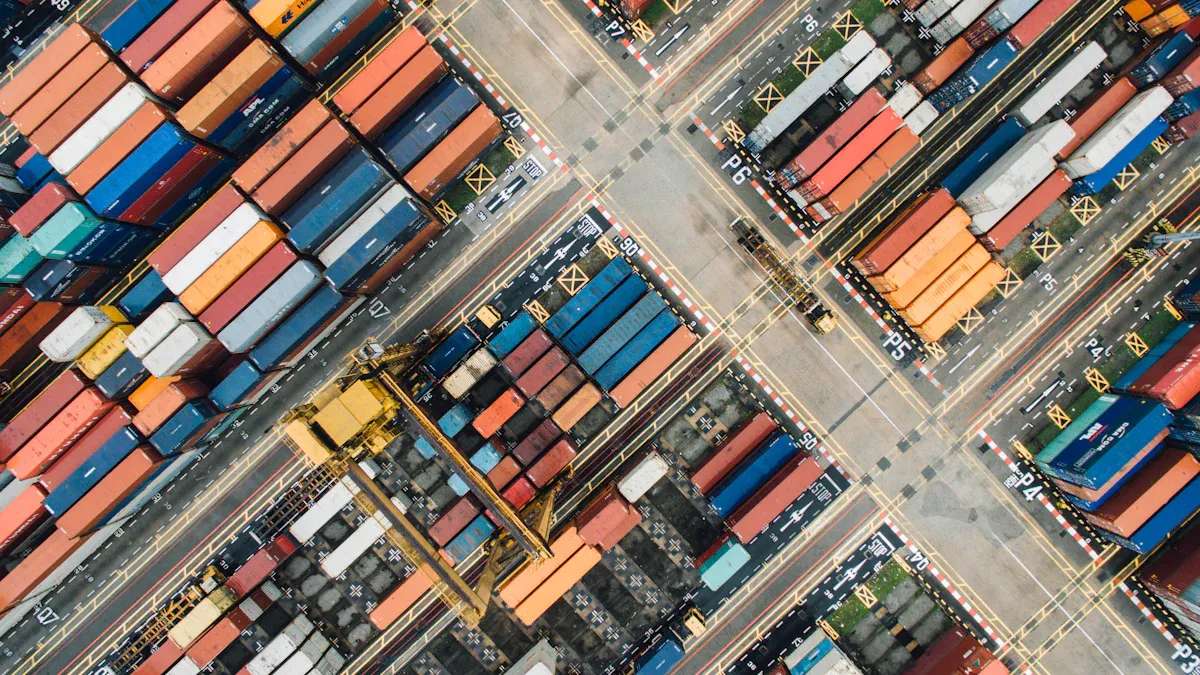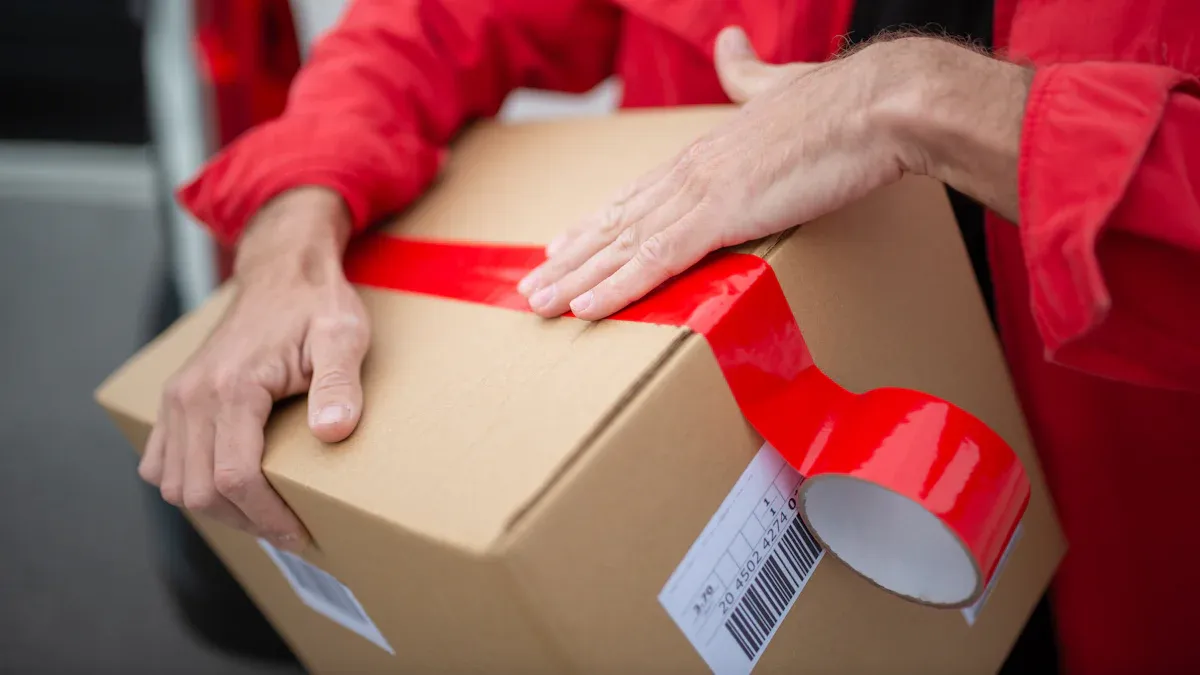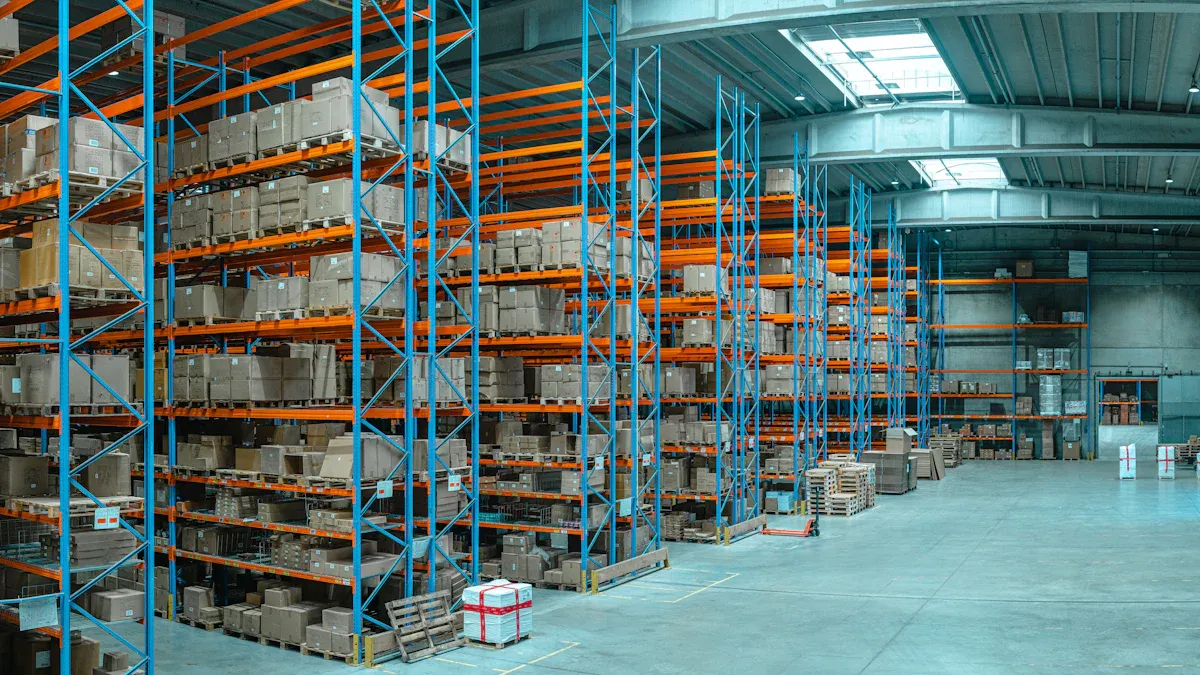How to Choose the Right Provider for Complex Shipment Logistics Solutions

When you choose a partner for complex shipment logistics solutions, you must match their strengths to your business needs. Focus on the most important qualities. Experts say you should look for:
Industry experience and expertise
Proven track record of success
Scalability and flexibility
Technology and innovation
Strong network and infrastructure
A provider with these qualities helps you handle changing shipping challenges. You can start by listing your needs and checking each provider’s skills.
Key Takeaways
Identify your shipping needs by assessing volume, frequency, and special requirements. This helps you find a provider that fits your business.
Research potential providers by checking their reputation, experience, and specialization in your industry. Look for proven success and strong customer reviews.
Evaluate technology and infrastructure. Choose a provider with modern tools for tracking and managing shipments to improve efficiency.
Understand pricing models and watch for hidden fees. Clear pricing helps you avoid unexpected costs and ensures you get good value.
Test the provider's service with a pilot project. This allows you to see how they handle real shipments before committing long-term.
Assess Your Needs

Shipment Volume & Frequency
You should start by looking at how much you ship and how often you send shipments. If you move large volumes or ship frequently, you can get better rates and lower transportation costs. Regular shipments help you keep inventory flowing and respond quickly to market changes. If you ship smaller loads often, less-than-container load (LCL) shipping can help you save money and keep your supply chain flexible.
Tip: Write down your average shipment size and how many times you ship each month. This helps you compare providers and find the best fit for your business.
Destinations & Coverage
Think about where your shipments need to go. Some providers have a wide network of warehouses and fulfillment centers. This helps you deliver goods on time and control costs. You also need to check if the provider offers the right insurance for your shipments. For example, liability insurance protects against damage or injury during transport. Cargo insurance covers your goods, and extra coverage may be needed for high-value or sensitive items.
Insurance Type | Coverage Amount | Description |
|---|---|---|
Liability insurance | Protects against damage to property or injuries during transport. | |
Cargo insurance | Standard $100,000 | Covers general freight needs; higher coverage may be needed for valuable shipments. |
Workers' compensation | N/A | Protects against liability for injuries to workers handling freight. |
General commercial liability | N/A | Covers business operations beyond transportation. |
Physical damage insurance | N/A | Protects carrier's equipment, indicating financial responsibility. |
Additional considerations | N/A | Discuss coverage for high-value, hazardous, or temperature-sensitive goods with carriers. |
Special Requirements
Some shipments need special care. You may ship lithium batteries, oversized equipment, or high-value items. These require trained employees, special permits, and extra security. For example, lithium batteries must be stored at the right temperature and follow hazardous materials rules. Oversized equipment needs heavy-duty transport and storage. High-value shipments need environmental controls and real-time tracking to prevent loss.
Category | Special Requirements |
|---|---|
Lithium Batteries | Must be stored at proper temperatures, trained employees, and compliance with hazardous materials regulations. |
Oversized Equipment | Requires specialized transport, permits, and storage facilities with heavy-duty equipment. |
High-Value Shipments | Needs environmental controls, heightened security, and real-time tracking systems to prevent loss. |
When you understand your needs, you can choose complex shipment logistics solutions that match your business and keep your goods safe.
Research Providers
Reputation & Experience
You want a provider with a strong reputation and proven experience. Start by reading customer reviews and testimonials. These show how well the provider handles real-world challenges. Look for providers who share their performance metrics. Important metrics include order accuracy rate, delivery time, and lead time. These numbers help you see if the provider can deliver on time and without mistakes.
Description | |
|---|---|
Capacity Utilization | Shows if the provider can handle your demand. |
Equipment Utilization Rate | Checks if they have enough equipment for your shipments. |
Truck Turnaround Rate | Measures how quickly trucks load and unload at their facilities. |
Driver Performance | Looks at driver quality and safety. |
Lead Time | Tracks the time from order to delivery. |
Order Accuracy Rate | Shows how often orders are correct. |
Delivery Time | Measures how fast shipments arrive. |
Tip: Make a list of providers with strong reputations and experience in your industry. This helps you focus your search.
Specialization
You need a provider who understands your business. Check if they specialize in your type of shipments or industry. For example, if you ship hazardous materials or oversized equipment, look for providers with the right permits and training. Ask about their network and technology. Providers with advanced tracking and automated notifications can handle complex shipment logistics solutions better.
Review your business needs and shipment types.
Check if the provider has a strong network and proven results in your industry.
Make sure they can cover all your shipping locations.
Ask about their technology for tracking and efficiency.
References & Case Studies
Ask providers for references and case studies. These show how they solve problems for other businesses. Look for stories that match your needs. For example, a provider who managed a buffer warehouse helped a company handle inventory changes. Another provider created custom fleet solutions to cut costs and boost efficiency. These examples prove the provider can handle complex shipment logistics solutions.
Case Study Title | Description | Key Outcomes |
|---|---|---|
Managing Marine Corps’ Supply Chain | Coordinated logistics for 130 stores, cut costs. | Reduced freight costs by 15%. |
Buffer Warehousing Approach | Managed inventory changes with buffer warehouses. | Improved focus on core processes. |
Custom Fleet Solutions | Built custom fleets for a building products company. | Lowered costs, raised efficiency. |
Expedited Freight Solutions | Supported time-sensitive domestic freight. | Faster delivery for urgent loads. |
Note: Use a request for proposal (RFP) to compare providers. List your goals and needs. This helps you see which provider fits best.
Evaluate Complex Shipment Logistics Solutions

When you compare complex shipment logistics solutions, you need to look beyond basic shipping. You want a provider with a full suite of capabilities, strong adaptability, and wide geographic coverage. These qualities help you handle changes in demand, new markets, and unexpected challenges.
Technology & Infrastructure
Modern technology and strong infrastructure set top providers apart. You should look for digital tools that make your shipping process easier and more reliable. Many leading companies use unified digital platforms. These systems let you track shipments, manage invoices, and see reports in one place. Real-time tracking and mobile apps give you live updates and help your team work faster.
Feature | Description |
|---|---|
Unified digital platforms | Centralizes shipment tracking, invoicing, freight management, and reporting within an integrated system, enhancing decision-making. |
API connectivity | Offers flexible APIs for real-time data exchange and end-to-end shipment visibility. |
Mobile applications | Enables seamless communication and live status updates, facilitating efficient data capture from the field. |
Data analytics & business intelligence | Provides actionable insights into performance metrics and sustainability goals through cloud-hosted dashboards. |
Strategic partnerships | Collaborates with cloud-based platforms like Salesforce and Workiva to enhance sustainability tracking and reporting. |
You also benefit from smart warehousing, automated transportation, predictive analytics, and cloud-based logistics platforms. These tools help you make better decisions and keep your shipments moving smoothly.
Tip: Ask providers about their technology stack and how it supports your business goals.
Service Range & Flexibility
A provider with a broad service range can handle many types of shipments. Flexibility means they can adjust to your needs, even when things change quickly. Third-party logistics companies (3PLs) often manage buying goods, storing them, and keeping track of stock. They also help with paperwork, customs, and following shipping rules. This support reduces your stress and saves time.
3PLs can scale their services up or down based on your demand.
They help you during peak seasons or when your business grows.
They offer expertise in handling special shipments, like hazardous materials or oversized goods.
You should choose a provider who can adapt to new challenges and keep your supply chain running.
Scalability
Scalability shows how well a provider can grow with your business. You want a partner who can handle more shipments as your company expands. To measure scalability, you should look at key performance indicators (KPIs). These numbers show how well the provider manages orders, deliveries, and inventory.
Metric | Description |
|---|---|
Measures the percentage of deliveries made on time, crucial for customer satisfaction and trust. | |
Order accuracy | Evaluates the correctness of orders fulfilled, impacting operational efficiency. |
Inventory management performance | Assesses how well inventory is managed, affecting the ability to scale operations effectively. |
Other important metrics include financial performance, operational efficiency, and fulfillment rates. Top providers often achieve on-time delivery rates above 95%. Industry averages range from 85% to 90%. High on-time delivery rates lead to better customer loyalty. In fact, 69% of shoppers say they will not return to a retailer after a late delivery.
Note: Use these metrics to compare providers and see who can support your growth.
Compliance & Sustainability
You need a provider who follows all rules and cares about the environment. Compliance covers customs, safety, and environmental laws. Providers must handle paperwork for international shipments and follow safety standards for hazardous goods. Environmental compliance shows a commitment to reducing carbon footprints.
Compliance Standard | Description |
|---|---|
Customs Regulations | A complex web of rules and paperwork that logistics companies must navigate for international trade. |
Safety Standards | Essential for handling hazardous materials, ensuring employee and public safety. |
Environmental Compliance | Reflects a commitment to sustainability and adherence to regulations aimed at reducing carbon footprint. |
Many companies now focus on ESG (Environmental, Social, and Governance) standards. Meeting these standards helps you avoid fines and improves your reputation. It also attracts investors and new customers.
Tip: Ask providers how they balance sustainability with profitability and how they report on ESG goals.
What to Look For
When you evaluate complex shipment logistics solutions, keep these criteria in mind:
Adaptability
Costs and pricing structure
Location and international service network
Sales and customer service quality
Tracking and delivery options
Inventory management
Insurance coverage
Technology integration
Security measures
Adaptability is especially important. It helps you face new challenges and keeps your logistics partnership strong. Providers who adapt well can handle market changes, new technology, and unexpected events.
Remember: The right provider will help you stay competitive and grow your business over time.
Cost & Transparency
Pricing Models
You need to understand how logistics providers set their prices. Providers use different pricing models to match your shipment needs. Some charge by each transaction, which works well if your shipment volume changes often. Others use storage-based pricing, so you pay for the space your goods take up. Pay-as-you-go pricing lets you pay only for the services you use, which helps if your business is just starting out. Some providers take a percentage of your revenue, and others combine several models for more flexibility.
Description | Best For | |
|---|---|---|
Contract Rates | Rates set for a specific period, allowing flexibility in response to market changes. | Shippers looking for stability amidst market volatility. |
Spot Rates | One-time rates based on current market conditions, ideal for variable shipments. | Shippers with fluctuating volumes and destinations. |
Transaction-Based Pricing | Pay per action or unit, suitable for businesses with variable sales volumes. | E-commerce retailers and startups. |
Storage-Based Pricing | Charges based on inventory storage, predictable costs for stable inventory. | Companies with large or slow-moving products. |
Pay-As-You-Go Pricing | Pay only for services used, ideal for businesses with variable order volumes. | Startups or businesses with fluctuating demand. |
Revenue Percentage Model | Pay a percentage of revenue for fulfillment services. | High-revenue e-commerce businesses. |
Hybrid Pricing | Combines multiple models for flexibility. | Larger businesses with complex logistics needs. |
Tip: Ask providers to explain their pricing model and how it fits your shipment patterns.
Hidden Fees
You should watch for hidden fees in logistics contracts. These extra costs can add up quickly and surprise you. Common hidden fees include:
Permit fees for oversized or overweight shipments
Escort vehicle charges for safety
Fuel surcharges that change with fuel prices
Tarping fees to protect your load
Penalties for missed appointments
Accessorial charges for extra services like detention or special handling
Note: Always review your contract for these fees before you sign.
Value Comparison
Comparing providers goes beyond price. You need to look at the overall value they offer. Some providers save you time and resources by managing shipments for you. Others bring deep industry knowledge, advanced technology, and strong risk management. Providers with large carrier networks help you get better freight rates and capacity.
Advantage | Description |
|---|---|
Providers manage shipments, freeing up your team for other tasks. | |
Knowledge and Expertise | Providers know the industry and help you avoid costly mistakes. |
Technology | Advanced systems improve efficiency and save money. |
Cost Savings & Efficiencies | Providers help you cut costs in operations, staffing, and technology. |
Risk Management | Providers handle regulations and reduce your liability. |
Freight Carrier Network | Providers give you access to more carriers, improving pricing and capacity. |
Remember: The best provider gives you clear pricing, avoids hidden fees, and delivers real value for your business.
Test Service & Support
Customer Service
You need strong customer service from your logistics provider. Good providers give you many ways to get help. You can call, email, or use chat. This is called omnichannel support. You also want help at any time. Many top providers offer 24/7 service. If you ship to other countries, you need support in different languages. Multilingual teams make communication easy.
Good customer service means more than just answering questions. You want a team that listens, solves problems, and puts your needs first.
Here are key standards you should expect:
Omnichannel options for support
24/7 availability
Multilingual help
Focus on keeping your business running smoothly
You should also look for effective communication, reliability, and adaptability. Providers who think about your needs help you avoid problems and keep your shipments moving.
Support During Disruptions
Disruptions can happen at any time. You need a provider who acts fast when things go wrong. Leading companies use rapid response teams to recover cargo after incidents. They work with emergency partners, like locksmiths, to secure vehicles and warehouses. Many providers use advanced cybersecurity to protect your data and systems.
Some providers use predictive analytics. This helps them spot problems before they grow. They also set up backup plans, like extra suppliers or emergency warehouses. These steps keep your shipments safe and your business running.
Rapid response teams for quick recovery
Emergency partners for immediate help
Cybersecurity for digital safety
Backup networks for smooth operations
Pilot Project
Before you sign a long-term contract, you should test the provider’s service. A pilot project lets you see how they handle your shipments. Start by setting clear goals for the test. Use real shipment data and real situations. Work closely with the provider and your team. Share feedback and track results.
Tip: A pilot project helps you find strengths and weaknesses before you commit.
Follow these steps for a successful test:
Define your goals and what you want to learn.
Choose the right way to test.
Use real data and real shipments.
Work together and share feedback.
A pilot project gives you confidence in your choice and helps you build a strong partnership.
Choosing the right provider for complex shipment logistics solutions means matching your needs with a partner’s strengths. Focus on these steps:
Ensure compliance and sustainability.
Prioritize scalability and flexibility.
"Your 3PL provider is a critical partner. Their financial stability, ability to scale with your business growth, and communication effectiveness are vital for a successful relationship."
Start your evaluation today by using these criteria to find a provider who delivers reliability and transparency.
FAQ
What should you look for in a logistics provider’s technology?
You should look for real-time tracking, easy-to-use dashboards, and strong data security. These tools help you see your shipments and keep your information safe. Ask about mobile apps and system integration.
How do you compare logistics providers’ pricing?
Always ask for a clear price list. Check for hidden fees. Compare the total cost, not just the base rate. Look at what services each provider includes in their price.
Why does provider scalability matter?
Scalability lets your provider handle more shipments as your business grows. You avoid delays and missed deliveries. A scalable provider helps you meet customer demand during busy times.
How can you test a provider before signing a contract?
You can run a pilot project. Use real shipments and set clear goals. Track results and give feedback. This test shows if the provider meets your needs.
What happens if your shipment faces a disruption?
Many providers use rapid response teams. They fix problems fast and keep your goods safe. Ask if your provider has backup plans and emergency contacts.
See Also
PGL's Warehouse Solutions Ensure Quick Delivery Across The East Coast
Enhancing International Operations With Innovative Logistics Solutions
Understanding PGL's B2B Warehousing And Distribution On The East Coast
Key Strategies For Effective Management Of Global Logistics
PGL's Specialized Solutions For LTL And FTL Freight Shipping
